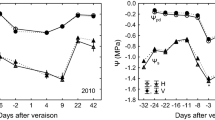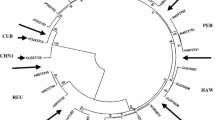Abstract
Sugarcane cultivars with a high (susceptible cultivars) and low (resistant cultivars) virus titer of Sugarcane yellow leaf virus were grown in the field. The carbohydrate composition in green leaf tops and in stems was determined. In RT-PCR of leaf extracts, susceptible cultivars had a high SCYLV-titer, whereas resistant cultivars had a very low titer. The cultivars differed in biomass yield, but these differences were not correlated with susceptibility. However, carbohydrate composition did have susceptibility-specific differences. Hexose levels were lower in green leaf tops and stalks of susceptible (strongly infected) cultivars than in those of resistant (weakly infected) cultivars. The stalks of susceptible cultivars also had less starch than those of resistant cultivars. Thus, the viral susceptibility (and infection) affected sugar metabolism. In addition, a positive correlation between hexose and starch in stems and between hexose and sucrose in green leaf tops was observed. The results from susceptible versus resistant cultivars were the opposite of those in the comparison between infected versus virus-free lines of the same cultivar. The breeding process apparently had unintentionally selected clones with modulated carbohydrate metabolism to avoid or compensate for the adverse effects of SCYLV infection.




Similar content being viewed by others
References
Comstock JC, Irvine JE, Miller JD (1994) Yellow leaf syndrome appears on the United States mainland. Sugar J 56:33–35
Comstock JC, Irey MS, Lockhart BEL, Wang ZK (1998) Incidence of yellow leaf syndrome in CP cultivars based on polymerase chain reaction and serological techniques. Sugar Cane 4:21–24
Fitch MMM, Lehrer AT, Komor E, Moore PH (2001) Elimination of Sugarcane yellow leaf virus from infected sugarcane plants by meristem tip culture visualized by tissue blot immunoassay. Plant Pathol 50:676–680
Lehrer AT, Komor E (2008) Symptom expression of yellow leaf disease in sugarcane cultivars with different degrees of infection by Sugarcane yellow leaf virus. Plant Pathol 57:178–189
Lehrer AT, Moore PH, Komor E (2007) Impact of Sugarcane yellow leaf virus (ScYLV) on the carbohydrate status of sugarcane: comparison of virus-free plants with symptomatic and asymptomatic virus-infected plants. Physiol Mol Plant Pathol 70:180–188 (addition 71: 260)
Lehrer AT, Wu KK, Komor E (2009) Impact of Sugarcane yellow leaf virus on growth and sugar yield of sugarcane. J Gen Plant Pathol 75:288–296
Payne JH (ed) (1968) Sugar cane factory analytical control: the official methods of the Hawaiian Sugar Technologist. Elsevier, Amsterdam
Rassaby L, Girard J-C, Letourmy P, Chaume J, Irey MS, Lockhart BEL, Kodja H, Rott P (2003) Impact of Sugarcane yellow leaf virus on sugarcane yield and juice quality in Réunion Island. Eur J Plant Pathol 109:459–466
Sambrook J, Russell DW (2001) Molecular cloning: a laboratory manual, 3rd edn. Cold Spring Harbor Laboratory Press, Cold Spring Harbor.
Schenck S (1990) Yellow leaf syndrome—a new sugarcane disease. Annual report no. 38, Hawaiian Sugar Planters Association, Aiea
Schenck S, Lehrer AT (2000) Factors affecting the transmission and spread of Sugarcane yellow leaf virus. Plant Dis 84:1085–1088
Vega J, Scagliusi SMM, Ulian EC (1997) Sugarcane yellow leaf disease in Brazil: evidence of association with a luteovirus. Plant Dis 81:21–26
Woo H-H, Orbach MJ, Hirsch AM, Hawes MC (1999) Meristem-localized inducible expression of a UDP-glycosyltransferase gene is essential for growth and development in pea and alfalfa. Plant Cell 11:2303–2315
Yan S-L, Lehrer AT, Hajirezaei MR, Springer A, Komor E (2009) Modulation of carbohydrate metabolism and chloroplast structure in sugarcane leaves which were infected by Sugarcane yellow leaf virus (SCYLV). Physiol Mol Plant Pathol 73:78–87
Acknowledgments
The authors are grateful to the field workers of the Hawaii Agriculture Research Center for their help and to the staff of the analytical lab for standard sugar determinations. Thanks to Alberto Bertolini, University Udine, who participated in the in situ starch determination project. This work was funded by Deutsche Forschungsgemeinschaft and by Deutscher Akademischer Austauchdienst, which supported Yan Shih-Long, Alberto Bertolini and Blanca Fontaniella.
Author information
Authors and Affiliations
Corresponding author
Rights and permissions
About this article
Cite this article
Lehrer, A., Yan, SL., Fontaniella, B. et al. Carbohydrate composition of sugarcane cultivars that are resistant or susceptible to Sugarcane yellow leaf virus . J Gen Plant Pathol 76, 62–68 (2010). https://doi.org/10.1007/s10327-009-0210-0
Received:
Accepted:
Published:
Issue Date:
DOI: https://doi.org/10.1007/s10327-009-0210-0




